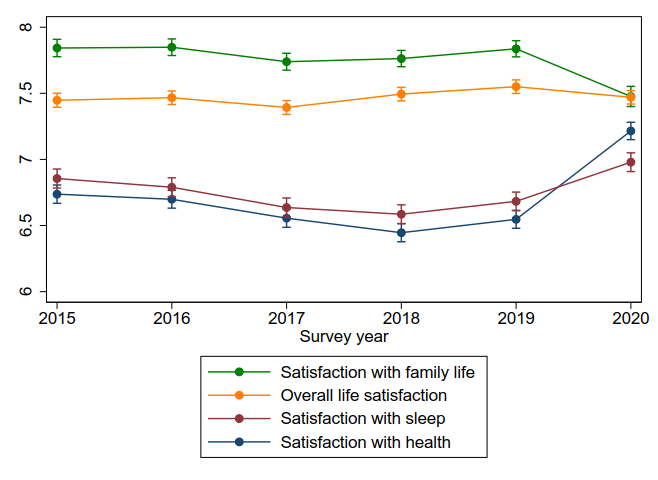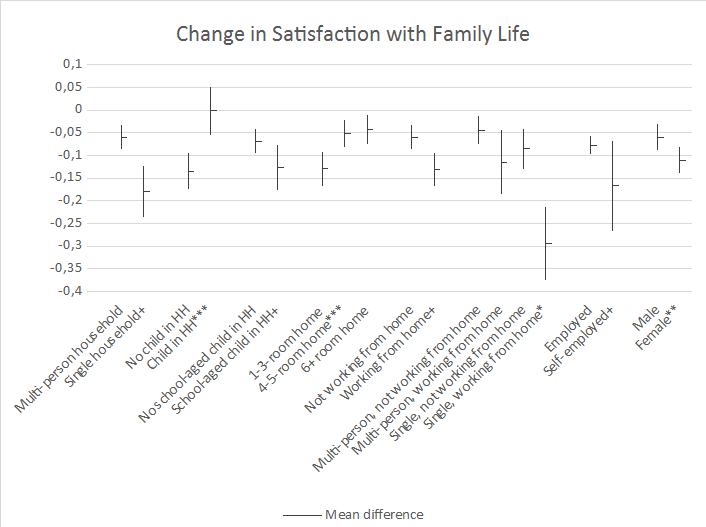Spotlights of the SOEP-CoV Study (2)
Version: September 22, 2020
Family Life in Lockdown
By Stefan Liebig
The measures put in place to fight the coronavirus pandemic are also affecting family life in Germany. For people who live alone, policies limiting contact with individuals outside the household have hit particularly hard. Multi-person households also face new challenges with the closure of childcare facilities and reduction of care services for disabled or elderly family members. The impacts appear to be both positive and negative, at least based on anecdotal evidence: On the one hand, families struggle with being confined together at home, especially when personal space is limited. On the other hand, the restrictions on public life also allow families to spend more time, and possibly more “quality time”, together.
Yet the negative and positive impacts are not the same for everyone. A family living in a spacious apartment with parents working from home may cope better with lockdown than a family living in cramped conditions with parents working reduced hours or in frontline jobs. Respected gender researchers have also noted that the corona crisis may be reinforcing traditional gender roles.
To analyze this situation in more detail, the longitudinal Socio-Economic Panel (SOEP) study launched the telephone survey SOEP-CoV (www.soep-cov.de). What is unique about this study is that there is already a wide range of information available on the living situations of the households surveyed—some of it dating back to 1984. This allows us to measure the changes brought about by the current situation very precisely and to assess the broader impacts of the crisis. The changes revealed in the data include changes in satisfaction with family life.
How has the lockdown affected satisfaction with family life?
Comparing SOEP data from 2019 with the SOEP-CoV data from April 2020—the middle of the lockdown—we see that satisfaction with family life has declined overall. While mean satisfaction in 2019 was 7.8 on a scale of 0 to 10, it fell to 7.5 in April 2020. The difference appears particularly striking when looking at the fluctuations over recent years in the figure below: Satisfaction with family life has otherwise been relatively stable since 2015, varying only in the second decimal place.

But the crucial question is: Has everyone been affected to the same extent? And in particular, how have working people been affected? They are bearing significant burdens in the current crisis, whether because they are caring for children while working from home, dealing with the challenges of working remotely, or coping with a drop in income from self-employment.
In the following, we focus on changes in satisfaction with family life among the employed population. The figure below presents the results of a regression model in which we estimated the change in satisfaction with family life from 2019 to 2020 for a series of characteristics. It shows the mean change in family satisfaction after controlling for a number of additional characteristics (marginal effects). Negative values indicate that, if the respective characteristic is present, satisfaction with family life falls by the respective amount on average; the null value signifies no change; and positive values indicate an increase in satisfaction (the scale ranges from -2.4 to +2.4).

Comments: (i) Data: SOEP-CoV, Tranche 1-3, 2,465 respondents, weighted results, marginal effects are reported based on a linear regression model (further covariates: East/West, age, resilience, satisfaction with family life in 2019. (ii) Only significant effects on regression results are shown: + p<.10, * p<.05, ** p<.01, ***p<.001. (iii) The change in satisfaction with family life were calculated as logarithmic differences in values for satisfaction from 2019 and 2020. The values at the two points in time are each measured on an 11-point scale (0 for completely dissatisfied to 10 for completely satisfied).
Overall, we observe a decrease in satisfaction with family life in 38% of employed respondents, no change in 39%, and an increase in satisfaction in 23%. The change in satisfaction with family life during lockdown (in April 2020) was greater in single households than in multi-person households: As expected, individuals living alone were most severely affected by the restrictions on social contact. In households with children, however, we do not see the decline in satisfaction that is observed for the employed population as a whole, although this is not true across the board: Households with school-aged children do show a decline in satisfaction with family life, likely due to the school closures. The role of spatial conditions is apparent when looking at the effects of dwelling size on satisfaction with family life: The sharpest decrease in satisfaction is observed among families in homes with three rooms or fewer. Those living in larger homes (four or more rooms) show significantly lower decreases in satisfaction with family life. Individuals working from home, and especially those living alone, tend to report lower satisfaction with family life. This suggests that working from home leads to a loss of satisfaction with family life, especially among people who live alone. The same is true for the self-employed: The changes in working life have a direct effect on satisfaction with family life, especially for those working from home and living alone. Finally, women report a significantly lower level of satisfaction with family life than men. Since we are looking only at those currently in employment, this reflects the dual burden of household and work, which falls most heavily on women.
Takeaway:
Our analysis shows that families with children are experiencing the corona crisis as less burdensome when comparing survey data from April 2020 to data from 2019. Employed people who live alone and are working from home are the group most impacted by social distancing: They may be experiencing working from home as lonely and may want more contact with family members. This also points to the ambivalent effects of working from home: It can lead to feelings of isolation and loneliness, particularly among those who live alone. The classic patterns of inequality (beyond income inequality) are apparent in satisfaction with family life: Families with more spacious homes experience lockdown as less of a burden on family life. The same is true of men, who appear to be less severely affected by lockdown than women, especially when it comes to reported satisfaction with family life.

